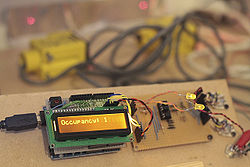Difference between revisions of "Project:Spacensus"
| Line 17: | Line 17: | ||
==Location== | ==Location== | ||
| − | The [http://www.flickr.com/photos/travelbot/5421523049/ current mounting location] has the lasers In close proximity in the middle of the entrance way. To avoid issues with occlusion of beams by coats etc, the coat hooks have been moved to the next wall along, with the lab coats. This arrangement greatly simplifies the detection of the true direction of someone entering/leaving the space. | + | The [http://www.flickr.com/photos/travelbot/5421523049/ current mounting location] has the lasers In close proximity in the middle of the entrance way. To avoid issues with occlusion of beams by coats etc, the coat hooks have been moved to the next wall along, with the lab coats. This arrangement greatly simplifies the detection of the true direction of someone entering/leaving the space. Detection works reasonably well. |
| − | |||
| − | Detection works reasonably well | ||
The occupancy level is currently [http://hack.rs/cacti/graph.php?action=view&local_graph_id=35&rra_id=all charted on cacti]. The [https://github.com/londonhackspace/spacensus python script] that provides the data to cacti implements only the 'pool for status' command, but will later allow more control and configuration of the counting sensors. | The occupancy level is currently [http://hack.rs/cacti/graph.php?action=view&local_graph_id=35&rra_id=all charted on cacti]. The [https://github.com/londonhackspace/spacensus python script] that provides the data to cacti implements only the 'pool for status' command, but will later allow more control and configuration of the counting sensors. | ||
Revision as of 19:39, 14 February 2011
| Spacensus
| |
|---|---|
| Members | Elliot |
| QR code | |
Part of the London Hackspace graphs and visualisations project.
Overview
I have located two Laser Diode Retroreflective Sensors in our stores which I intend to use to monitor space occupancy by having the beams cross the main doorway. The beams will be staggered so that direction (arriving, leaving) can be determined by the order in which the beams are broken. I was thinking of mounting them at waist height.
- This will probably get caught out by clusters of people: --81.105.17.61
- We only need an approximate count
- The doorway is narrow so it's unlikely that the steps of more than one individual will overlap.
- Most of the time people won't arrive in clusters
- Can we detect some other event such as the door opening after a prolonged lights-out period to force the count to zero? --81.105.17.61
- Yes, using the door/lights data for reset would be good if we get large amounts of drift - but I don't plan to just yet
- This might fail if people spend the night there. AIUI this happens rarely enough that we may not care about the inaccuracy.
- We could also use some kind of probabilistic model with the 'door-open' and 'bell' data
Location
The current mounting location has the lasers In close proximity in the middle of the entrance way. To avoid issues with occlusion of beams by coats etc, the coat hooks have been moved to the next wall along, with the lab coats. This arrangement greatly simplifies the detection of the true direction of someone entering/leaving the space. Detection works reasonably well.
The occupancy level is currently charted on cacti. The python script that provides the data to cacti implements only the 'pool for status' command, but will later allow more control and configuration of the counting sensors.
Sensors
These sensors appear to be in working order. They'd should be safe to use below child-head height. They were manufactured in 1996 and use a Class II laser rated at 3mW with a wavelength of 655-670nm (datasheet). The model number is: Q45BB6LL
A good signal can be obtained at 1.5m by using a reflector made of aluminium tape.
Code
The code is available on GitHub - please be kind it's my first Arduino project and I know the code is filth.
